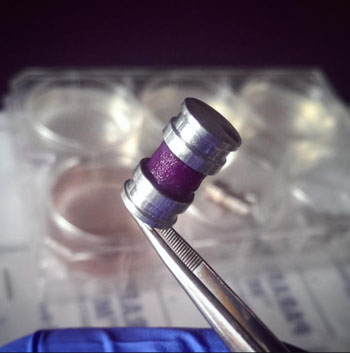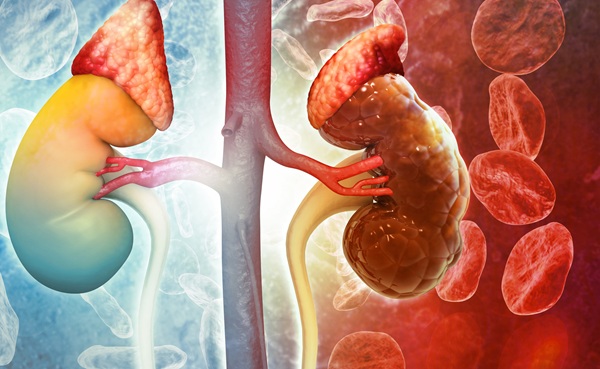Researchers Culture Novel Three-Dimensional Artificial Tumors
|
By LabMedica International staff writers Posted on 07 Dec 2015 |

Image: This rolled-up strip of engineered tissue allows researchers to mimic the way cells grow in a tumor, yet it can be unrolled in seconds for detailed analysis (Photo courtesy of Darren Rodenhizer, University of Toronto Engineering).
A team of Canadian cancer researchers has developed a novel method for growing three-dimensional cultures of cancer cells that behave as artificial tumors and which can be readily resolved to evaluate the response of individual cells to different levels of oxygen and nutrients.
The cells growing in the center of a tumor have reduced access to oxygen and nutrients as compared to those growing near the surface, nearer to blood vessels. These subtle, location-dependent environment differences influence cell behavior, but their effect has proven difficult to replicate in laboratory culture.
Investigators at the University of Toronto (ON, Canada) have reported the development of a novel culture system in the form of a rolled-up sheet that mimics the three-dimensional environment of a tumor, yet can also be taken apart in seconds.
The investigators impregnated a short strip of a porous, paper-like support material with collagen and cancer cells. The strip was then incubated for 24 hours in a nutrient-rich culture solution, which allowed the cells to adjust to their new environment. The strip was then rolled around a metal core, forming an artificial tumor, which was then cultured for several more days before performing analysis of tumor cell behavior. By unrolling the strip, the model could be rapidly disassembled for snapshot analysis, allowing spatial mapping of cell metabolism in concert with cell phenotype.
Results published in the November 23, 2015, online edition of the journal Nature Materials revealed that as the oxygen level decreased in internal areas of the tumor roll, the number of dead cells increased, which indicated that the cells had responded to the oxygen gradient.
Cells able to live under hypoxic conditions were found to behave differently than the surface cells: for example, they more strongly expressed genes associated with low oxygen conditions. Changes in gene expression, as determined by liquid chromatography tandem mass spectrometry metabolic signature analysis, were gradual and continuous along the length of the strip.
Senior author Dr. Alison McGuigan, professor of chemical engineering at the University of Toronto, said, "The technology holds great promise for the field of personalized medicine. The idea would be to take a patient's own cells and create copies of their tumor. These copies could then be subjected to various treatments and analyzed by the simple unrolling process, providing information about what is likely to work best for that specific patient. It is very translatable and transferable to other labs. We definitely want others to use it, because the larger the community, the more applications we will discover."
Related Links:
University of Toronto
The cells growing in the center of a tumor have reduced access to oxygen and nutrients as compared to those growing near the surface, nearer to blood vessels. These subtle, location-dependent environment differences influence cell behavior, but their effect has proven difficult to replicate in laboratory culture.
Investigators at the University of Toronto (ON, Canada) have reported the development of a novel culture system in the form of a rolled-up sheet that mimics the three-dimensional environment of a tumor, yet can also be taken apart in seconds.
The investigators impregnated a short strip of a porous, paper-like support material with collagen and cancer cells. The strip was then incubated for 24 hours in a nutrient-rich culture solution, which allowed the cells to adjust to their new environment. The strip was then rolled around a metal core, forming an artificial tumor, which was then cultured for several more days before performing analysis of tumor cell behavior. By unrolling the strip, the model could be rapidly disassembled for snapshot analysis, allowing spatial mapping of cell metabolism in concert with cell phenotype.
Results published in the November 23, 2015, online edition of the journal Nature Materials revealed that as the oxygen level decreased in internal areas of the tumor roll, the number of dead cells increased, which indicated that the cells had responded to the oxygen gradient.
Cells able to live under hypoxic conditions were found to behave differently than the surface cells: for example, they more strongly expressed genes associated with low oxygen conditions. Changes in gene expression, as determined by liquid chromatography tandem mass spectrometry metabolic signature analysis, were gradual and continuous along the length of the strip.
Senior author Dr. Alison McGuigan, professor of chemical engineering at the University of Toronto, said, "The technology holds great promise for the field of personalized medicine. The idea would be to take a patient's own cells and create copies of their tumor. These copies could then be subjected to various treatments and analyzed by the simple unrolling process, providing information about what is likely to work best for that specific patient. It is very translatable and transferable to other labs. We definitely want others to use it, because the larger the community, the more applications we will discover."
Related Links:
University of Toronto
Latest BioResearch News
- Genome Analysis Predicts Likelihood of Neurodisability in Oxygen-Deprived Newborns
- Gene Panel Predicts Disease Progession for Patients with B-cell Lymphoma
- New Method Simplifies Preparation of Tumor Genomic DNA Libraries
- New Tool Developed for Diagnosis of Chronic HBV Infection
- Panel of Genetic Loci Accurately Predicts Risk of Developing Gout
- Disrupted TGFB Signaling Linked to Increased Cancer-Related Bacteria
- Gene Fusion Protein Proposed as Prostate Cancer Biomarker
- NIV Test to Diagnose and Monitor Vascular Complications in Diabetes
- Semen Exosome MicroRNA Proves Biomarker for Prostate Cancer
- Genetic Loci Link Plasma Lipid Levels to CVD Risk
- Newly Identified Gene Network Aids in Early Diagnosis of Autism Spectrum Disorder
- Link Confirmed between Living in Poverty and Developing Diseases
- Genomic Study Identifies Kidney Disease Loci in Type I Diabetes Patients
- Liquid Biopsy More Effective for Analyzing Tumor Drug Resistance Mutations
- New Liquid Biopsy Assay Reveals Host-Pathogen Interactions
- Method Developed for Enriching Trophoblast Population in Samples
Channels
Clinical Chemistry
view channel
POC Breath Diagnostic System to Detect Pneumonia-Causing Pathogens
Pseudomonas aeruginosa is a major cause of hospital-acquired and ventilator-associated pneumonia, particularly in lung transplant recipients and patients with structural lung disease. Its ability to form... Read more
Online Tool Detects Drug Exposure Directly from Patient Samples
Doctors often rely on patient interviews and medical records to determine what medications a person has taken, but this information is frequently incomplete. People may forget drugs they used, take over-the-counter... Read moreMolecular Diagnostics
view channel
Blood Biomarker Improves Early Brain Injury Prognosis After Cardiac Arrest
After a cardiac arrest, many patients remain unconscious for days, leaving doctors and families facing uncertainty about whether meaningful recovery is possible. Current tools to assess brain damage, including... Read more
Biomarkers Could Identify Patients at High Risk of Severe AKI After Major Surgery
Acute kidney injury is one of the most common and dangerous complications after major surgery, particularly among patients in intensive care. Even mild impairment of kidney function can lead to long-term... Read more
CLIA Test Identifies Head and Neck Cancer Recurrence from Post-Surgical Lymphatic Fluid
While the lymphatic system’s critical role in metastasis has long been recognized, routine access to patient lymph has been elusive. Now, a non-invasive process can access lymph through the collection... Read moreHematology
view channel
MRD Tests Could Predict Survival in Leukemia Patients
Acute myeloid leukemia is an aggressive blood cancer that disrupts normal blood cell production and often relapses even after intensive treatment. Clinicians currently lack early, reliable markers to predict... Read more
Platelet Activity Blood Test in Middle Age Could Identify Early Alzheimer’s Risk
Early detection of Alzheimer’s disease remains one of the biggest unmet needs in neurology, particularly because the biological changes underlying the disorder begin decades before memory symptoms appear.... Read more
Microvesicles Measurement Could Detect Vascular Injury in Sickle Cell Disease Patients
Assessing disease severity in sickle cell disease (SCD) remains challenging, especially when trying to predict hemolysis, vascular injury, and risk of complications such as vaso-occlusive crises.... Read more
ADLM’s New Coagulation Testing Guidance to Improve Care for Patients on Blood Thinners
Direct oral anticoagulants (DOACs) are one of the most common types of blood thinners. Patients take them to prevent a host of complications that could arise from blood clotting, including stroke, deep... Read moreImmunology
view channelBlood Test Could Detect Adverse Immunotherapy Effects
Immune checkpoint inhibitors have transformed cancer treatment, but they can also trigger serious immune-related adverse events that damage healthy organs and may become life-threatening if not detected early.... Read more
Routine Blood Test Can Predict Who Benefits Most from CAR T-Cell Therapy
CAR T-cell therapy has transformed treatment for patients with relapsed or treatment-resistant non-Hodgkin lymphoma, but many patients eventually relapse despite an initial response. Clinicians currently... Read moreMicrobiology
view channel
Blood-Based Diagnostic Method Could Identify Pediatric LRTIs
Lower-respiratory tract infections (LRTIs) are a leading cause of illness and death worldwide, and pneumonia is the leading infectious cause of death in children under five, claiming the lives of over... Read more
Rapid Diagnostic Test Matches Gold Standard for Sepsis Detection
Sepsis kills 11 million people worldwide every year and generates massive healthcare costs. In the USA and Europe alone, sepsis accounts for USD 100 billion in annual hospitalization expenses.... Read moreRapid POC Tuberculosis Test Provides Results Within 15 Minutes
Tuberculosis remains one of the world’s deadliest infectious diseases, and reducing new cases depends on identifying individuals with latent infection before it progresses. Current diagnostic tools often... Read more
Rapid Assay Identifies Bloodstream Infection Pathogens Directly from Patient Samples
Bloodstream infections in sepsis progress quickly and demand rapid, precise diagnosis. Current blood-culture methods often take one to five days to identify the pathogen, leaving clinicians to treat blindly... Read morePathology
view channel
Rapid Low-Cost Tests Can Prevent Child Deaths from Contaminated Medicinal Syrups
Medicinal syrups contaminated with toxic chemicals have caused the deaths of hundreds of children worldwide, exposing a critical gap in how these products are tested before reaching patients.... Read more
Tumor Signals in Saliva and Blood Enable Non-Invasive Monitoring of Head and Neck Cancer
Head and neck cancers are among the most aggressive malignancies worldwide, with nearly 900,000 new cases diagnosed each year. Monitoring these cancers for recurrence or relapse typically relies on tissue... Read more
Common Health Issues Can Influence New Blood Tests for Alzheimer’s Disease
Blood-based tests for Alzheimer’s disease are transforming diagnosis by offering a simpler alternative to spinal taps and brain imaging. However, many people evaluated at memory clinics also live with... Read more
Blood Test Formula Identifies Chronic Liver Disease Patients with Higher Cancer Risk
Chronic liver disease affects millions worldwide and can progress silently to hepatocellular carcinoma (HCC), one of the deadliest cancers globally. While surveillance guidelines exist for patients with... Read moreTechnology
view channel
Machine Learning Models Diagnose ALS Earlier Through Blood Biomarkers
Amyotrophic lateral sclerosis (ALS) is a rapidly progressive neurodegenerative disease that is notoriously difficult to diagnose in its early stages. Early symptoms often overlap with other neurological... Read more
Artificial Intelligence Model Could Accelerate Rare Disease Diagnosis
Identifying which genetic variants actually cause disease remains one of the biggest challenges in genomic medicine. Each person carries tens of thousands of DNA changes, yet only a few meaningfully alter... Read moreIndustry
view channel
BD and Penn Institute Collaborate to Advance Immunotherapy through Flow Cytometry
BD (Becton, Dickinson and Company, Franklin Lakes, NJ, USA) has entered into a strategic collaboration with the Institute for Immunology and Immune Health (I3H, Philadelphia, PA, USA) at the University... Read more




















